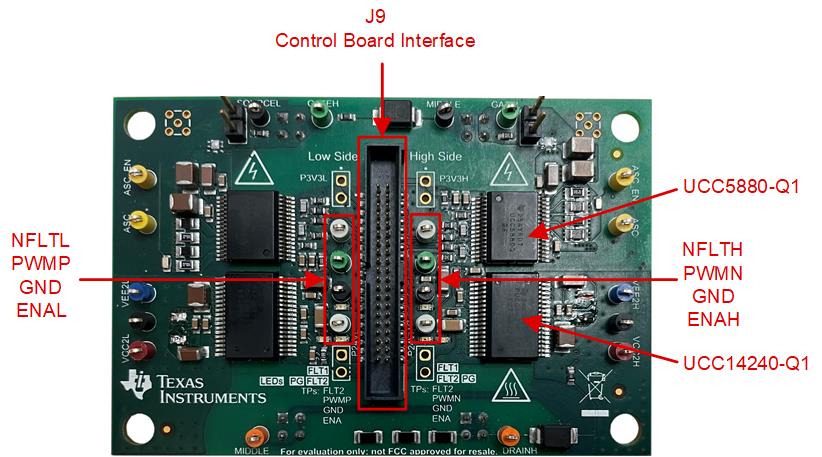TIDUF23 may 2023
- Description
- Resources
- Features
- Applications
- 5
- 1System Description
- 2System Overview
-
3Hardware, Software, Testing Requirements,
and Test Results
- 3.1 Hardware Requirements
- 3.2 Test Setup
- 3.3 Test Procedure
- 3.4 Test Results
- 4General Texas Instruments High Voltage Evaluation (TI HV EVM) User Safety Guidelines
- 5Design and Documentation Support
- 6Terminology
3.1.1.4 Gate Driver and Bias Supply Board
The components and accessible test points on the gate drive and bias supply board are shown on the Figure 3-4. Pinouts of the J9 connector are described in the Table 3-2.
 Figure 3-4 Gate Driver and Bias Supply
Board
Figure 3-4 Gate Driver and Bias Supply
BoardTable 3-2 Connector J9 Pinout
| Pin | Signal | Pin | Signal |
|---|---|---|---|
| 1 | P3V3H_T | 2 | GND |
| 3 | PV3VL_T | 4 | GND |
| 5 | SDIL_T | 6 | NCSH_T |
| 7 | NCSL_T | 8 | SDOH_T |
| 9 | GND | 10 | CLK |
| 11 | GND | 12 | PWMN |
| 13 | GND | 14 | PWMP |
| 15 | GND | 16 | GND |
| 17 | ASCL_T | 18 | N_FLT2H_T |
| 19 | GND | 20 | N_FLT1H_T |
| 21 | GD2L_T | 22 | GD0H_T |
| 23 | GD1L_T | 24 | GD1H_T |
| 25 | GD0L_T | 26 | GD2H_T |
| 27 | GND | 28 | ASC_EN |
| 29 | N_FLT1L_T | 30 | ASCH_T |
| 31 | N_FLT2L_T | 32 | GND |
| 33 | EN_PSL_T | 34 | N_PGH_T |
| 35 | N_PGL_T | 36 | EN_PSH_T |
| 37 | P24VH_T | 38 | GND |
| 39 | P24VL_T | 40 | GND |